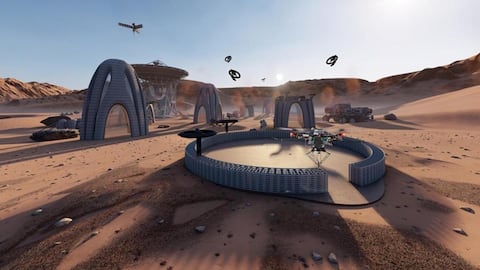These mind-blowing bee-inspired drones can 3D-print buildings
What's the story
A swarm of drones is busy rebuilding a bridge that collapsed during an earthquake... No, this is not the beginning of a chapter in a dystopian fiction. Instead, this is a glimpse into our near future. A team of scientists has developed a unique fleet of 3D printers-cum-drones that can build and repair structures. These drones are inspired by bees. Here are more details.
Context
Why does this story matter?
Builder drones that mimic bees or wasps are seen as the next step in the evolution of civil engineering. Apart from making the building process easy, they are expected to make repairing structures that are affected by natural disasters easy, too. The popularity of 3D printing has been on a rise in construction as well. So, this new development should increase that manifold.
Drones
The technology behind builder drones is Aerial Additive Manufacturing
The fleet of 3D printing drones is developed by scientists from the Imperial College London and Switzerland's Empa research institution. The technology used here is called Aerial Additive Manufacturing (Aerial-AM). These builder drones work collectively from a single blueprint and are inspired by natural builders like bees and wasps. They cooperate in the building process and even adapt their technique as they go.
Autonomous
The drones are fully autonomous
The builder drones are fully autonomous, but they are monitored by a human controller. The human controller jumps in if the situation calls for it and checks progress. The drones adapt to the geometry of the structure they are building with the help of both 3D printing and a path-planning framework. This means they can be used for creating intricate structures.
Types of drones
There are two kinds of drones in the fleet
The fleet of drones includes two kinds of drones: BuilDrones and ScanDrones. BuilDrones are the ones responsible for building the structure. Through a nozzle on their underside, the BuilDrones deposit successive layers of materials by working collectively. ScanDrones supervise the printing process. They evaluate the geometry of the structure and advise BuilDrones on what to do next.
Test
How accurate is the building process?
The researchers conducted an experiment to test the working of drones. The proof-of-concept prints include a 2.05m high cylinder (72 layers) with a polyurethane-based foam material and an 18cm high cylinder (28 layers) with a pseudoplastic cementitious material. Throughout the process, the drones assessed the geometry of the structure in real-time and adapted their behavior to meet specifications, with a manufacturing accuracy of 5mm.
Official words
'Drones can help construct and repair building in difficult-to-reach areas'
The study about bee-like builder drones was recently published in the journal Nature. About the technology, lead author Mirko Kovac said, "We've proved that drones can work autonomously and in tandem to construct and repair buildings, at least in the lab." "Our solution is scalable and could help us to construct and repair [buildings] in difficult-to-reach areas in the future."
